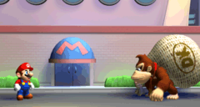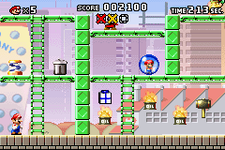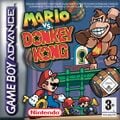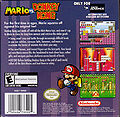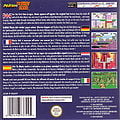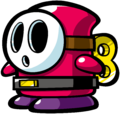Mario vs. Donkey Kong
Template:Articleabout Template:Infobox Mario vs. Donkey Kong is a game for the Game Boy Advance. It brings back Mario and Donkey Kong's rivalry from the Mario series' first game, Donkey Kong. The game returns many elements from the original Donkey Kong game, such as the construction site setting, Mario's being vulnerable from heights, and using the hammer. The game also borrows elements from Super Mario Bros. 2, especially with picking up enemies and items. Despite bringing elements from previous platformers, Mario vs. Donkey Kong is more of a puzzle platformer; Mario must find the best route to complete the level by hitting switches and interacting with other objects, often in a specific order. This game spawned multiple sequels and became its own series; this is the only game in the series, however, to feature Mario himself as a playable character since the later games have the player control Mini-Marios. The game was re-released as a free downloadable title for the 3DS on December 16, 2011. However, it was only available to people who purchased a 3DS prior to the August 12, 2011 price drop, meaning they had to be a part of the Nintendo 3DS Ambassador Program.
Story
Mario has become so famous in the Mushroom Kingdom that he has decided to establish the Mario Toy Company, which has developed a new toy called the Mini-Mario. As Donkey Kong surfs through the channels of his television set, he sees a commercial for the Mini-Marios. Donkey Kong instantly adores the toys and heads to the Toy Store, but finds that they are sold out. Donkey Kong turns around and sees the Mario Toy Company, deciding to loot the store. The store is managed by Toads, but they do nothing to stop Donkey Kong from stealing the toys. Mario then notices Donkey Kong and starts chasing him.
After Mario chases Donkey Kong for a while, he eventually checks his bag, only to see all the Mini-Marios he stole have dropped, with Mario, the toys, and the three Toad employees laughing at him. Enraged, he grabs the three Toads, climbs the building, and Mario rescues the three Toads while fighting Donkey Kong. Upon his defeat, he falls off onto a truck full of Mini-Marios and steals thirty-six more, now with keys attatched. Mario gives chase once again, until a similar cutscene occurs in which he checks the bag again. Only Mario laughs until six Mini-Marios come out. Donkey Kong then grabs the Minis with a giant robot, to which Mario promptly frees while fighting Donkey Kong, eventually wrecking the machine and electrocuting Donkey Kong in the process. After that, Mario is about to scold Donkey Kong for what he did, but finds that Donkey Kong is crying in pity and shame. Mario cheers him up by giving him a free Mini-Mario. Donkey Kong gets what he has wanted all along while Mario and the remaining Mini-Marios celebrate.
Gameplay
Each of the games six worlds is divided into eight levels. For the first six levels within each world, Mario must find a key and open up a door to the second half of the level, which is a checkpoint. There, Mario will find the toy that Donkey Kong dropped. If Mario is defeated in the second half of the level, his points reset to zero. At the beginning of each level, there is short sequence showing what Mario needs to do or what he may face before playing the level. This short sequence also explains what moves Mario needs to use to complete the level, showing some button combinations.
Unlike other Mario games, when Mario takes a hit, he loses a life. He can also lose a life from getting squished and falling on from a great height and landing on his head. If the fall is not big enough, Mario may get stunned on his back instead. There is also a time limit, which is similar to the traditional Super Mario Bros. games; if the time limit is low, an alarm plays and Mario panics. If the time limit runs out, Mario loses a life. Also unlike other Mario games, however, Mario has more moves he can use, such as jump, handstand, and and even higher jump. To defeat enemies, Mario must pick up objects and throw them at enemies, reminiscent of Super Mario Bros. 2. Throughout the level, there are some collectibles Mario can collect. Three are pivotal in earning a high score, which are different colored presents. Earning a high enough score, beating the default socre, earns a star for that level. The stars later are used to unlock Expert levels.
Once Mario completes a level and collects enough presents, he can play a short minigame to earn extra lives. One present may have a 1-up, one may have a 3-up or 5-up, and one present may have nothing; this is shown at the beginning of the minigame. One minigame is stopping a scrolling arrow on top of the desired present while the other has Mario swapping presents so Donkey Kong's fist squashes an undesired present.
The seventh level in each world is a Mini-Mario level. Mario leads the six Mini-Mario toys he collected back to their toy chest; however, he must make sure they avoid obstacles along the way. This leads into a battle with Donkey Kong, with each Mini-Mario saved becoming a "hit point". For example, if Mario saves all six of the Mini-Mario toys, he'll be able to be hit six times by Donkey Kong before losing a life. If the player fails to defeat Donkey Kong and chooses to replay the fight without doing the Mini-Mario level, Mario will start the fight with four hit points.
After Mario has beaten the six worlds and defeated Donkey Kong, six "Plus" Worlds are unlocked, numbered 1+, 2+, and so on. There are seven stages in each Plus Worlds, and there are no Mini-Mario levels. Mario must get to a Mini-Mario holding a key and lead it to the exit doorway. There is only one part per level in the Plus Worlds, and they are designed to be more difficult than the main worlds. There are still Donkey Kong boss levels in the Plus Worlds.
After beating all of the Plus Worlds, Mario fights Donkey Kong for the final time. If the player found all of the remaining presents in replay mode, the "Expert" levels will unlock; instead of completing them one at a time, the player must beat the game's default high scores (from the "Main" and "Plus" levels) to progressively unlock the levels.
The Japanese version of the game features e-Reader support and had space for 12 levels, but only 5 cards were released.
Controls
 - Jumps
- Jumps - Picks up item
- Picks up item - Moves Mario
- Moves Mario /
/ - Selects between worlds
- Selects between worlds- Pauses and continues game.
Mario's moves
- Jump (
 )
) - Handstand (Down
 +
+  )
) - Handstand jump (
 while handstanding)
while handstanding) - Double handstand jump (
 after touching the ground from handstand jump)
after touching the ground from handstand jump) - Backflip (while facing right) (Left
 +
+  )
)
Worlds
| Mario Toy Company is the first world, where Donkey Kong stole the Mini-Mario toys. This world features trash cans, Mini Shy Guys, and a few other gimmicks. | |
| Donkey Kong Jungle Donkey Kong's next stop, where Mario must navigate through to collect the toys. This world features ropes, Venus Fire Traps, and RamRams. | |
| Fire Mountain is a fiery mountain, possibly a volcano. This world features Podoboos, fiery Nitpickers, and lava. | |
| Spooky House is a haunted mansion, featuring Boos, Polterguys, Thwomps, and others. | |
| Mystic Forest is a world featuring Bob-ombs, Conveyor Belts, and many other gimmicks. | |
| Twilight City is a city featuring robotic Monchees, lasers, and a "final" battle with Donkey Kong. |
Plus Worlds
- Mario Toy Factory
- Donkey Kong Jungle Plus
- Fire Mountain Plus
- Spooky House Plus
- Mystic Forest Plus
- Twilight City Plus
After clearing Twilight City Plus, Mario faces Donkey Kong for the final time.
Items and features
| Item | About |
|---|---|
| Keys are found in the first half of every regular level of the game. They must be taken to locked doors in order to open the second half. | |
| Mini Marios are the objective of the second half of the normal levels, where they must be rescued from orbs. They follow Mario in Mini Mario levels. | |
| File:MvsDK 1-UP.gif1-Up Mushroom | 1-Up Mushrooms give Mario an extra life. |
| Switches are found in three versions: red, yellow and blue. As the main effect, the switch that is active makes platforms, blocks and ladders of the same color available to use. | |
| Springs help Mario to jump higher. | |
| Conveyor Belts appear in mass in some levels. They are used to transport keys and to help Mario through narrow areas. Their direction can be changed with a switch. | |
| Donut Lifts are platforms that fall down if Mario stays too long on them. | |
| Elevators are found moving on lines. Their directions can be changed with a switch. | |
| Trash Cans can be carried and thrown by Mario. | |
| Hammers are found floating on platforms. Mario can use them to defeat enemies, such as the Oil. The can be thrown upwards and grabbed again while in the air. | |
| Presents are found in red, yellow and blue variations. They are used to a bonus game in the end of a level, as well as opening the Plus Worlds. | |
| The letters T-O-Y are found in Mini Mario levels. They must be collected by Mini Marios to open the Toy Box. | |
| Toy Boxes are the goal of the Mini Mario levels. If the letters T-O-Y are collected, it opens and allows Mario to drop off his Mini-Marios. |
Enemies
| Enemy | About |
|---|---|
| Bats are enemies that, once released, fly horizontally through the stage. If they touch Mario, they latch on to him, causing him to fall from the rope he is climbing. | |
| Black Shy Guys appear in Twilight City. They attack by throwing wrenches at Mario. | |
| Blowtorch Guys are found in Fire Mountain. Besides walking from side to side, they also blow fire that can harm Mario. | |
| Bob-Ombs are dropped by some dispensers. They fuse up when Mario is near and explode moments later. | |
| Boos appear in Spooky House. They chase Mario while he is not looking at them, and cower while being watched. | |
| File:Brickman.PNGBrick Monster | Brick Monsters are placed on platforms. They throw three lines of bricks under them, forcing Mario to handstand to avoid being hit. |
| Candles appear in Spooky House, where they have the ability float up and down. If Mario touches one, he gets burnt and loses an extra life. | |
| Cannons tilt up and down, shooting cannonballs. | |
| Falling Spikes fall from ceilings when Mario gets near them. They can also get stuck on the ground, and turn into platforms to the player. | |
| Fires walk from side to side on an area. They burn Mario once they touch him. | |
| Mini Ninjis jump up and down, similarly to regular Ninjis. This can help Mario to reach higher areas. | |
| Simple enemies that move side to side continuously. | |
| Monchees are mechanical monkeys with long tails that hang below the platforms they are on. Mario can use these tails as ropes without getting harmed. However, he still loses an extra life if he touches a Monchee's body. | |
| Nitpickers are small birds that float horizontally once they leave their nests. They also drop polka-dotted eggs at Mario. | |
| Oil is found in cans with "OIL" written on their sides and fire coming out of them. They move up and down and burn Mario if he touches them. | |
| Podoboos are found jumping out from lava. | |
| Polterguys move from side to side. There are three variations of this species: blue, red and yellow. If a switch of their respective color is pressed, they turn into stationary blocks. | |
| RamRams are found in jungle levels. Despite being enemies, they are used as platforms a few times. They can only be defeated by fruit. | |
| Sir Shovalots are firstly seen walking on platforms. But once they spot Mario, they use their front surfaces to shove him. This can be harmful when Mario touches a wall, but it also helps him to go through narrow places. | |
| Sleeping Spear Guys are firstly seen sleeping, hence their name. Once Mario gets near them, they wake up and start running after him. The back to sleep if they touch a platform edge. | |
| Snapjaws are seen climbing ropes in forest levels. They can be defeated by fruit only. | |
| Thwimps jump from side to side, trying to crush Mario. They are invincible. | |
| Thwomps watch the ground and try to crush Mario if he walks under them. Switch-controlled blocks can be used to prevent them from reaching the player. | |
| Thwomp Blocks fall from the ceiling, just like Thwomps. However, they keep falling even if Mario is not near. They can be used as platforms. | |
| Trash Cans look exactly like the items of the same name. They reveal themselves if Mario gets near and start walking. Mario can grab and throw them as normal Trash Cans. | |
| Venus Fire Traps are found stationary on platforms, usually near ropes. They spit fireballs to harm Mario. | |
| Donkey Kong is the only boss of the game, fought in every world. In each of his fights, he attacks Mario in a different manner. |
Development
The game was initially planned as Donkey Kong Plus, an updated version of the Game Boy Donkey Kong game. The only known difference between the original and Plus, aside from the graphics, was the addition of a level designer, to be used through the Nintendo GameCube's Game Boy Player. However, the game vanished the following year, and was replaced by Mario vs. Donkey Kong, with the level editor gone and the graphics replaced with pre-rendered graphics. However, the game's sequel, Mario vs. Donkey Kong 2: March of the Minis had this feature and took advantage of Wi-Fi Connection.
Staff
- Main article: List of Mario vs. Donkey Kong staff
Mario vs. Donkey Kong is one of the few Mario games to be developed by an American team, Nintendo Software Technology Corporation (NST). In NST's team, Shigeki Yamashiro is the producer while Yukimi Shimura is the director. Wing S. Cho designed the game and Yoonjoon Lee is the engineering director.
Gallery
Boxart and logo
- MvsDK Logo.png
English game logo
- JapLogo MvsDK.png
Japanese game logo.
Artworks
- MarioKey MvsDK.png
Mario holding a key.
- MvsDK-Mario Climbing Art.png
Mario climbing ropes.
- HandstandMVSDK.PNG
Mario performing a Handstand.
- MvsDK Monchee.png
Mario holding a Monchee's tail.
Media
Quotes
- Main article: List of quotes in Mario vs. Donkey Kong
Mario
- "Come back here, you big monkey!"
- "Ah, that Charles Martinet! Nice Italian boy."
- "Oh yeah, don't forget to thank Mr. Miyamoto!"
- ""Let's-a go, little guys!"
References to other games
- Super Mario Bros. 2: Picking up items serve a similar function. Shy Guys and Ninjis also make an appearance.
- Donkey Kong (Game Boy): The game was originally planned to be a Game Boy Advance remake of this game, but ended up being a semi-sequel. As such, it uses all gameplay elements from this game, although it has a very different story.
- Super Mario 64: Several of Mario's voice clips are recycled.
- Donkey Kong 64: Several of Donkey Kong's voice clips are recycled.
- Luigi's Mansion: Several of the Toads' voice clips are recycled.
- Super Mario Sunshine: Several of the Toads' voice clips are recycled.
